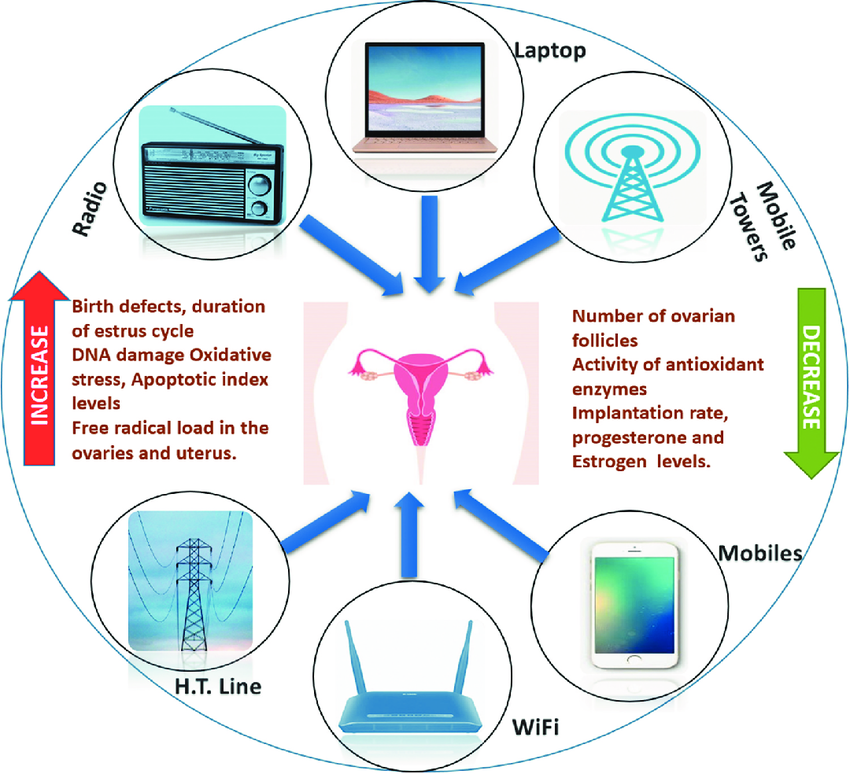Modern technology has transformed the way we live, work, and communicate, but it has also introduced new environmental factors that may be impacting our health in ways we are only beginning to understand. One of the most overlooked yet potentially dangerous exposures we face daily is electromagnetic fields (EMF). While much attention has been given to EMF’s effects on sleep, cognitive function, and oxidative stress, a growing body of research suggests that it may also have serious consequences for fertility. As male sperm counts continue to decline globally and infertility rates rise, it’s crucial to examine the hidden role EMFs may be playing in this crisis.
Understanding EMFs
Electromagnetic fields (EMFs) are invisible energy waves emitted by electrical and wireless devices. While some EMFs occur naturally, such as those from the Earth’s magnetic field, the rapid expansion of technology has dramatically increased human exposure to man-made EMFs.
1. Common Sources of EMF
Man-made EMFs come from a variety of sources, many of which are used in everyday life:
Cell Phones and Wi-Fi Routers – One of the most significant contributors to EMF exposure, as mobile networks and Wi-Fi signals continuously emit radiation.
Laptops and Tablets – Often used on laps, exposing the reproductive area directly to EMFs.
Bluetooth Devices – Wireless earbuds, smartwatches, and fitness trackers are constantly emitting low-level radiation.
Power Lines and Electrical Wiring – Homes, workplaces, and urban environments are filled with low-frequency EMFs from electrical systems.
Smart Meters – Used by utility companies to measure energy usage, these devices emit pulsed radiation frequently throughout the day.
Microwave Ovens – While enclosed, microwaves leak small amounts of radiation into the surrounding environment.
2. How EMFs Affect Us
Exposure to EMFs has been linked to various health concerns, including:
Oxidative Stress and Cellular Damage – EMFs generate excess free radicals, leading to DNA damage and inflammation.
Disrupted Sleep Cycles – EMFs interfere with melatonin production, a hormone critical for restful sleep and hormone regulation.
Cognitive Decline and Neurological Issues – Some research has associated long-term EMF exposure with memory problems, headaches, and brain fog.
Endocrine Disruption – EMFs interfere with hormone production, affecting testosterone, estrogen, and progesterone levels.
Fertility Issues – Perhaps most concerning, studies show that EMFs can negatively impact sperm health, egg quality, and pregnancy outcomes.
How EMF Affects Sperm Health
Fellas, the research is becoming impossible to ignore—EMF exposure is harming male fertility. A study published in Reproductive Biology and Endocrinology found that radiofrequency EMFs (RF-EMFs) from cell phones, laptops, and Wi-Fi reduce sperm count, motility, and viability. Another meta-analysis in Environment International confirmed that mobile phone exposure is consistently linked to lower sperm concentration and progressive motility.
Here’s a breakdown of how EMFs negatively impact sperm health:
- Lower Sperm Count – Research in Fertility and Sterility found that men with high EMF exposure had fewer sperm per milliliter of semen, likely due to increased oxidative stress.
- Weaker Sperm Motility – EMFs impair mitochondrial function, making sperm less mobile and decreasing the chances of fertilization.
- DNA Damage and Fragmentation – A study in PLOS ONE found that EMFs increase oxidative stress, leading to sperm DNA fragmentation, which is linked to infertility and birth defects.
- Reduced Testosterone Levels – Studies indicate that RF-EMF exposure disrupts Leydig cells, which are responsible for producing testosterone, leading to hormonal imbalances.
- Cumulative Long-Term Effects – Unlike other environmental toxins, EMF exposure is constant—from smartphones, laptops, Bluetooth devices, and Wi-Fi. Over time, this exposure builds up, leading to progressive damage to sperm and overall fertility.
Men who carry their phones in their pockets, use laptops on their laps, or frequently use Bluetooth devices are at a higher risk of infertility due to chronic exposure. With sperm counts already declining globally, reducing EMF exposure should be a key precautionary step for men looking to protect their reproductive health.
The Impact of EMF on Female Fertility
While much of the research on EMF and fertility has focused on male reproductive health, emerging evidence suggests that EMF exposure may also impact female fertility.
Here are just some of the ways that EMFs have proven to be harmful to women:
- Disrupt Ovarian Function – A study in Clinical and Experimental Reproductive Medicine found that exposure to EMFs has been linked to irregular menstrual cycles and altered hormone production, particularly estrogen and progesterone.
- Lower Egg Quality – A study in Bioelectromagnetics found that women with high EMF exposure had significantly lower levels of melatonin, a hormone essential for protecting ovarian follicles from oxidative stress.
- Increase Oxidative Stress – Just like in sperm, EMFs can increase free radical production in female reproductive cells, which may contribute to diminished egg viability.
- Affect Pregnancy Outcomes – Research from Yale University found that prenatal EMF exposure in mice led to a reduced ovarian follicle count in offspring, suggesting long-term fertility effects for future generations.
- Increased Risk of Miscarriage – A systematic review and meta-analysis published in Reproductive Toxicology concluded that women exposed to high levels of EMF during pregnancy had a significantly higher risk of miscarriage.
With modern life becoming increasingly wireless, women are exposed to EMFs from cell phones, Wi-Fi, and wearable tech more than ever before. Given the potential long-term impact on reproductive health, minimizing exposure and using EMF protection strategies is more important than ever.
EMF and Hormonal Disruptions
Hormones are the body’s internal messengers, regulating everything from metabolism to reproductive health. When this delicate system is disrupted, fertility struggles often follow. Emerging research suggests that EMFs interfere with endocrine function, particularly through their impact on cellular signaling and mitochondrial health.
- Disrupting Testosterone and Estrogen Balance – Research shows that EMFs alter testosterone levels in male rats, while additional studies have reported that female cows exposed to RF-EMFs experienced irregular estrous cycles and imbalanced progesterone levels.
- Mitochondrial Dysfunction and Hormone Production – Mitochondria are essential for energy production and hormone synthesis. Studies show that EMFs trigger an overload of calcium ions in cells, leading to oxidative stress and mitochondrial impairment—two major disruptors of hormone regulation.
- Impact on the Hypothalamic-Pituitary-Gonadal Axis – The HPG axis is the command center for reproductive hormone production. Some studies suggest that EMFs may interfere with this system, altering the signals that regulate testosterone, estrogen, and progesterone.
Unlike short-term environmental stressors, EMF exposure is continuous, meaning its effects on hormonal balance may accumulate over time. This could help explain why fertility rates are declining while endocrine-related disorders—like polycystic ovary syndrome (PCOS) and low testosterone—are on the rise.
EMF and Epigenetic Changes: Are We Passing the Effects to Future Generations?
One of the most overlooked aspects of EMF exposure is its potential impact on epigenetics—the way environmental factors influence gene expression. Unlike genetic mutations, which alter DNA sequences, epigenetic changes modify how genes are turned on or off. This means that EMF exposure today could have consequences not just for current reproductive health, but for future generations as well.
- Prenatal Exposure and Fertility Decline – One study found that mice exposed to EMFs during fetal development had fewer ovarian follicles in adulthood. This suggests that in-utero exposure to EMFs could reduce reproductive potential before birth.
- Sperm and Egg DNA Integrity – Research has shown that oxidative stress from EMF exposure leads to sperm DNA fragmentation, which may contribute to infertility, birth defects, or developmental disorders in offspring.
- Transgenerational Effects – Some studies indicate that EMF exposure could trigger heritable epigenetic changes, meaning that even if direct exposure is reduced, the next generation may still experience altered reproductive function due to inherited gene expression patterns.
This area of research is still evolving, but the potential long-term consequences are concerning. If EMF exposure can alter reproductive health at a cellular and genetic level, future generations may inherit fertility challenges that are only now coming to light. As wireless technology continues to expand, it may be time to consider whether our reliance on constant connectivity is silently shaping the future of human fertility.
Protecting Fertility from EMF Exposure
Given the growing body of evidence linking EMF exposure to reproductive health issues, it is crucial to take proactive steps to reduce EMF exposure, particularly for those trying to conceive. Here are some effective strategies:
Keep Electronic Devices Away from the Body: Avoid carrying cell phones in pockets or placing laptops on your lap. Use speakerphone or wired headsets instead of holding the phone directly against your head.
Limit Wireless Device Use: Reduce screen time, especially before bed, to minimize EMF-induced melatonin suppression.
Create an EMF-Free Sleeping Environment: Turn off Wi-Fi routers at night, keep your phone in airplane mode, and avoid placing electronic devices near your bed.
Grounding and Antioxidant Support: Spending time outdoors barefoot (earthing) can help neutralize EMF-induced oxidative stress. Antioxidant-rich foods such as blueberries, turmeric, and omega-3 fatty acids can also help counteract EMF-related oxidative damage.
- Use EMF Protection Devices: Aires Tech has developed advanced EMF protection technology designed to neutralize the effects of electromagnetic radiation. Their scientifically backed products offer a viable solution for reducing EMF exposure.
Aires Tech: Advanced EMF Protection for Fertility Health
One of the most effective ways to mitigate the effects of EMF exposure on fertility is by using scientifically backed EMF protection. Aires Tech has developed advanced EMF mitigation technology designed to neutralize the effects of electromagnetic radiation. Their products have been tested in peer-reviewed studies and are used by health-conscious individuals, athletes, and professionals worldwide. By integrating Aires Tech’s cutting-edge solutions, individuals looking to protect their reproductive health from EMF exposure can significantly reduce their risk of fertility complications.
Final Thoughts
The impact of EMFs on fertility is a growing concern that cannot be ignored. With declining sperm counts, increased infertility rates, and rising reproductive health disorders, it is crucial to take a closer look at the role of modern technology in this crisis. While more research is needed to fully understand the long-term consequences, the existing evidence is compelling enough to warrant precautionary measures. Protecting reproductive health in the digital age requires awareness, lifestyle adjustments, and the adoption of EMF mitigation strategies. The future of fertility may well depend on how we choose to navigate our relationship with technology today.






















